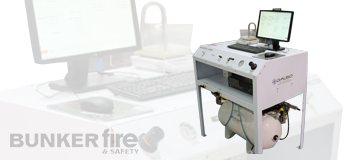Hydrostatic Cylinder Testing

What is Hydrostatic Testing and why is it important?
The cylinder requalification process starts with a careful visual inspection of the cylinder inside and out. Only after a satisfactory visual inspection, do we proceed to the Hydrostatic testing phase. Hydrostatic Testing is a nondestructive test procedure used to check cylinders for leaks, structural flaws, durability, corrosion, and a cylinder’s structural integrity. Testing is very important since compressed gas containers can explode if they fail. Testing consists of enclosing a cylinder filled with water inside a test jacket filled with water. Pressure is then applied internally to the cylinder, causing the cylinder to expand. The total and permanent volumetric expansions of the cylinder are determined by measuring the amount of water displaced by the expansion of the cylinder when under pressure and after the pressure has been released. An external and internal visual inspection of the cylinder is also performed, along with a dead-ring test for steel cylinders. Quite often, after hydrostatic testing, the cylinder remains slightly larger than it was prior to the testing phase (known as permanent expansion). In order for the cylinder to pass the hydrostatic test, the permanent expansion must not exceed 10% of the total expansion. For Aluminum and Composite fibre- wrapped cylinders the maximum is 5%, and TC-Metric Aluminum 6% expansion.
All cylinders must be requalified periodically in compliance with Transport Canada, CSA and CGA Standards. Transport Canada sets forth strict regulations regarding the handling, recharging, and transportation of Hazardous Materials. The use of properly trained cylinder requalification personnel is essential to ensure unsafe cylinders are removed from service. Designated employees are trained and certified in all aspects of cylinder requalification and testing. Our processes and services include:
- High pressure cylinder re-qualification using water jacket method (multiple jackets)
- Replacement of damaged valves
- All de-valved cylinders receive new “O” rings or Teflon